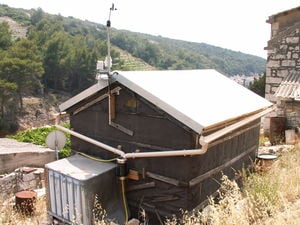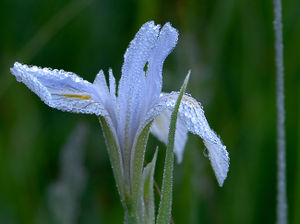| Line 61: | Line 61: | ||
<br> | <br> | ||
==== Collecting Dew ==== | ==== Collecting Dew from Rooftops==== | ||
Naturally forming dew is the most readily available way to obtain liquid water from the atmospheric vapor. | Naturally forming dew is the most readily available way to obtain liquid water from the atmospheric vapor. | ||
In certain climates, a significant amount of dew naturally forms on roofs. Just by collecting this dew, the average family sized roof can collect over 2L of potable water per night dew night. | |||
===== Construction ===== | |||
It is best to build a roof with dew collection in mind. The roof shape, slope, direction of slant, and material are all considerations. Particularly, roofs made out of plastic or galvinized iron . This article is written for those | |||
8.1 Materials | 8.1 Materials | ||
8.2 Tools | 8.2 Tools | ||
| Line 70: | Line 73: | ||
8.4 Estimated Costs | 8.4 Estimated Costs | ||
8.5 Case Studies | 8.5 Case Studies | ||
In Kutch, India, large-scale dew collection serves as a supplement to other sources of drinking water. Larger roofs have been outfitted with dew collection technology. | |||
=== Vapor concentrating dessicants === | === Vapor concentrating dessicants === | ||
Revision as of 21:31, 15 April 2010

Introduction
As the world’s population increases, fresh water supplies are being tapped out. Desalinization has become a necessary means of acquiring water; however current methods are usually quite costly and use fossil fuels. This is inappropriate for the developing world, where there is a serious need for increased fresh water availability. Atmospheric water vapor processing (AWVP) is an emerging technology in which the atmospheric water vapor is condensed and collected [1, 2, 9]. AWVP is a relatively new technology.
Opperating Principle
There is approximately 4 g of water vapor per cubic metre of air in the earths atmosphere [Landsberg (1972)]. This source of potable water is available virtually worldwide. AWVPs harvest this water, by condensing it from vapor to liquid.
Advantages
- It is at an early stage in development, but has the potential to provide environmentally acceptable alternatives [12, 13] to standard water supplies.
- Many AWVP designs favor decentralization of water distribution and avoidance of huge capital costs for infrastructure [13].
- AWVP can be made appropriate, community-managed and community-maintained for developing countries [review].
- AWVP methods are competitive with desalination plants and simpler and less expensive to operate and maintain.
- The amount of water produced would vary according to installation size, and be suitable to provide potable water to individuals or even thousands of people.
- AWVP production can take place in a wide variety of locations. Thus, expensive water distribution infrastructure can be reduced or avoided.
Disadvantages
[NEEEDS TO BE DONE]
Types of AWVPs
Currently, there are three main methods of taking moisture of air.
Cooled surface condensors
A surface is either cooled via a heatpump or refrigeration cycle, or with radiative cooling.
Radiative Cooling

Interestingly, many desert and costal plants and animals depend on this source [4]. Naturally, the phenomenon of dew formation takes place due to night sky radiation cooling. On a clear night, heat energy is radiated away from the earth’s surface into the sky. As the surface temperature drops below the dew point, water vapor will condense into droplets. Dew is formed both from water vapor in the atmosphere in the form of dewfall, as well as from water in the soil in the form of dewrise.
The amount of dewfall can be approximated from a complex turbulent fluid analysis; however it is far simpler to consider it as an energy balance problem [5]. The process of condensation releases heat, and thus raises the surface temperature.
Where
- R = net incoming radiation flux (a negative term)
- G = flux of total heat from soil to surface
- C = flux of sensible heat from air to surface
- F = flux of water vapor from air to surface
- λ = latent heat of vaporization
- Q = heat capacity of the air-grass layer per cm2
- T = mean temperature of layer
- M = heat released by vegetable metablism per cm2
Furthermore, it follows that the maximum possible condensation rate for combined dewfall and dew-rise during nighttime is [10, 11, 7, 8]:
Where
- Df = rate of dewfall in
- Dr = rate of dew rise in
- s = slope saturation curve in
- Q* = net radiation in
- γ = psychrometric constant
- λ = latent energy for vaporization in
Studies have demonstrated that the above modle can accurately and reliably predict dew rates [11].
The maximum amount of dewfall possible on a given night is limited by the amount of radiative cooling possible, and is estimated to be approximately 1 mm [6, 7]. In actuality, this number is usually much lower, ranging from 0.17 – 0.45 mm per night [8].
Collecting Dew from Rooftops
Naturally forming dew is the most readily available way to obtain liquid water from the atmospheric vapor.
In certain climates, a significant amount of dew naturally forms on roofs. Just by collecting this dew, the average family sized roof can collect over 2L of potable water per night dew night.
Construction
It is best to build a roof with dew collection in mind. The roof shape, slope, direction of slant, and material are all considerations. Particularly, roofs made out of plastic or galvinized iron . This article is written for those 8.1 Materials 8.2 Tools 8.3 Skills and Knowledge 8.4 Estimated Costs 8.5 Case Studies In Kutch, India, large-scale dew collection serves as a supplement to other sources of drinking water. Larger roofs have been outfitted with dew collection technology.





